Main Line Railways Connect Distant Cities, States
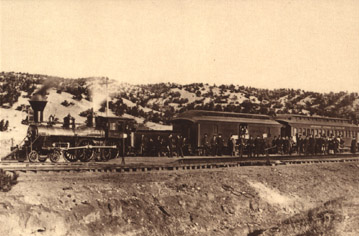 As railroad technology improved during the middle of the Nineteenth Century, main line rail lines
stretched further, connecting distant cities throughout New England, the Middle Eastern and Southern States. The dream many people shared of a railroad line connecting the West with the Eastern States became possible with the passage of the Pacific Railroad Act in 1862, chartering the Central Pacific to build from the West, and the Union Pacific to build from the East.
As railroad technology improved during the middle of the Nineteenth Century, main line rail lines
stretched further, connecting distant cities throughout New England, the Middle Eastern and Southern States. The dream many people shared of a railroad line connecting the West with the Eastern States became possible with the passage of the Pacific Railroad Act in 1862, chartering the Central Pacific to build from the West, and the Union Pacific to build from the East.
First Transcontinental Railroad
The Pacific Railroad Act of 1862 passed both the House and Senate in June 1862, and was signed by President Lincoln on July 1, 1862. The act of Congress chartered two railroad corporations to build the line, the Union Pacific to build westward from the Missouri River and the Central Pacific to build eastward from Sacramento, California.
A standard gauge of rails 4 feet 8 1/2 inches apart was established by the Pacific Railroad Act,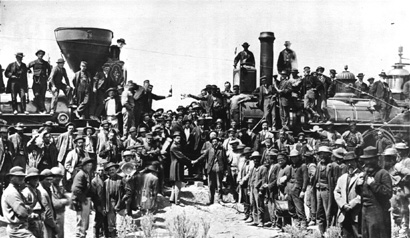 allowing cars to be interchanged between the railway companies.
allowing cars to be interchanged between the railway companies.
With completion of the Central Pacific and Union Pacific's Pacific Railroad 1,756 mile line between Sacramento and Omaha at Promontory, Utah on May 10, 1869, travel time from the East to San Francisco was reduced from weeks or months to about one week. California's products could be shipped to the cities in the East, in exchange for eastern manufactured goods. Mail could also be transported by rail. Farms, towns and cities were founded and grew along the route.
In 1872, the Union Pacific Missouri River Bridge opened connecting the Union Pacific with the Chicago and North Western Railway in Council Bluffs, Iowa, directly connecting the East and West by rail.
Southern Pacific Connect Southern California and Southwest with the East
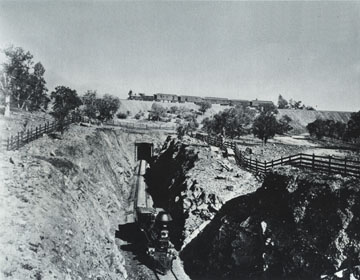 Southern California became linked with the Eastern cities with the opening of the Southern Pacific Railroad line between Los Angeles and San Francisco in 1876. A land boom began. Produce could be reasonably shipped east in exchange for manufactured goods.
Southern California became linked with the Eastern cities with the opening of the Southern Pacific Railroad line between Los Angeles and San Francisco in 1876. A land boom began. Produce could be reasonably shipped east in exchange for manufactured goods.
In March 1881, the Southern Pacific Railroad connected with the Atchison, Topeka and Santa Fe Railway at Deming, New Mexico, providing a connection to Atchison, Kansas on the Missouri River, thus completing a second railroad link to Los Angeles.
On December 15, 1881 the Southern Pacific connected with the Texas & Pacific at Sierra Blanca, Texas to complete an additional transcontinental railroad connection. Tracks connected with the the Galveston, Harrisburg and San Antonio Railway at the Pecos River on January 12, 1883. The golden spike was driven by Col. Tom Pierce, the GH&SA president. The Galveston, Harrisburg and San Antonio Railway provided a link with the Texas and New Orleans Railroad at Houston which connected Houston and New Orleans, linking the Gulf of Mexico with the Pacific Ocean. As the Union Pacific feared, The SP then started routing traffic to the southern line, diverting shipments from the UP.
A line along the California Coast
A rail line from San Jose southward was completed to Salinas in November 1872 and to Soledad in August 1873. Construction was completed from Soledad to Templeton in November 1886.
The Southern Pacific opened the southern leg of the Coast Line from Saugus to Carpenteria and Santa Barbara in August 1887. Construction continued to Ellwood in Goleta Valley in December 1887. The Coast Line was completed between Templeton and Ellwood in March 1901.
Atchison, Topeka & Santa Fe Railroad Provides Southern California Connection
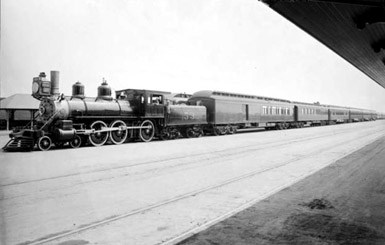 In the Fall of 1868 construction began in Topeka, Kansas on the Atchison, Topeka and Santa Fe line under the leadership of Cyrus K. Holliday. The Santa Fe was operating 28 miles of track in 1869. The line from Topeka to Atchison was completed in early 1872 and entered Colorado by the end of December. The line opened to Albuquerque in March 1880.
In the Fall of 1868 construction began in Topeka, Kansas on the Atchison, Topeka and Santa Fe line under the leadership of Cyrus K. Holliday. The Santa Fe was operating 28 miles of track in 1869. The line from Topeka to Atchison was completed in early 1872 and entered Colorado by the end of December. The line opened to Albuquerque in March 1880.
The Atchison, Topeka & Santa Fe Railroad and an affiliated road, the Atlantic & Pacific, reached the California boarder in 1883 where it connected with the Southern Pacific at Needles. In August 1884 the ATSF managed to reach an agreement to lease, then to buy the SP line from Needles to Mojave.
The Santa Fe affiliated California Southern Railroad line between San Diego, Fallbrook, Elsinore, Pinacate and San Bernardino, connected with the Santa Fe Route at Barstow on November 15, 1885, providing competition and direct service. Competition reduced prices, a ticket from the Mississippi River which had cost $125 was reduced to $25 or less by 1887. In 1887 the ATSF opened its own line from San Bernardino to Los Angeles via Glendora and Pasadena, making Los Angeles its principal Southern California terminus.
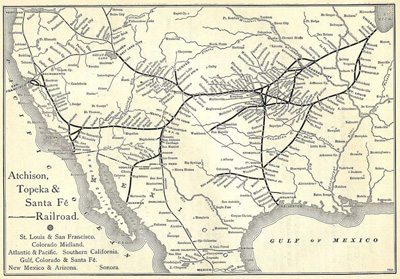 On April 29, 1888 the Chicago, Santa Fe & California line opened between Kansas City and Chicago, linking Chicago to the Santa Fe Route. The California Limited, Santa Fe's premier daily transcontinental passenger train, began service between Chicago and L.A. on November 27, 1892.
On April 29, 1888 the Chicago, Santa Fe & California line opened between Kansas City and Chicago, linking Chicago to the Santa Fe Route. The California Limited, Santa Fe's premier daily transcontinental passenger train, began service between Chicago and L.A. on November 27, 1892.
Railroads Built to Oregon
In 1878 the Oregon Railway and Navigation Company was chartered, including assets from the Oregon Steam Navigation company along the Columbia River, the Oregon Portage Railroad, a steam locomotive which had began service along the river in 1862, and the Walla Walla & Columbia River Railroad, a line which had been completed in 1875 between the Columbia River and the city of Walla Walla. By 1882, the line was completed between Walla Walla, Wallula and Portland.
In mid-1883 the OR&N line from Wallula to Portland became part of a transcontinental link, when the Northern Pacific was completed between Wallula and St. Paul, Min., providing the first all-rail link with the rest of the nation's railroad system. The OR&N extended its east line to the Snake River to meet the UP subsidiary Oregon Short Line.
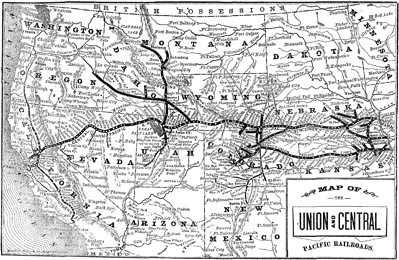 The Oregon Short Line Railroad was established on April 14, 1881, to construct a standard gauge line from Granger, Wyoming, through Idaho to a junction in Huntington, Oregon with the Oregon Railway and Navigation Company. This was necessary partly because the Union Pacific Railroad (UP) main line ended in Utah with the Central Pacific Railroad, part of the Southern Pacific Railroad which was building its own Southern transcontinental
line. The OSL also was meant to halt OR&N's continued eastward expansion at the Idaho-Oregon border.
The Oregon Short Line Railroad was established on April 14, 1881, to construct a standard gauge line from Granger, Wyoming, through Idaho to a junction in Huntington, Oregon with the Oregon Railway and Navigation Company. This was necessary partly because the Union Pacific Railroad (UP) main line ended in Utah with the Central Pacific Railroad, part of the Southern Pacific Railroad which was building its own Southern transcontinental
line. The OSL also was meant to halt OR&N's continued eastward expansion at the Idaho-Oregon border.
The Oregon Short Line line was completed to meet the OR&N line at the Snake River, completing another east-west transcontinental line in November 1884. In time, the OSL assumed control of the OR&N, thus giving the UP its desired outlet to the Pacific.
Construction began in 1869 on the Oregon & California Rail Road Company line from Portland through the Willamette Valley. Under the leadership of Ben Holladay, the line reached Salem in 1870, Eugene in 1871, Roseburg in 1872 and then stopped, with insufficient money to continue construction. Construction resumed in 1881 and reached Ashland in 1884. The financially troubled O&C Railroad was leased by the Southern Pacific in 1887. The Southern Pacific had resumed building its line north from Redding, the two lines were linked over Siskiyou Summit to form the Shasta Route in December 1887. The travel time between Portland and Sacramento was reduced from seven days by stagecoach to 38 hours by train.
The OR&N and the O&C encouraged logging, lumber manufacturing, export of wool and livestock, and sale of fruit, cereal crops, and other agricultural commodities to a vastly expanded market.
Railroad Lines Completed to Washington and the Pacific Northwest
| During the decade that followed, additional transcontinental rail lines were completed connecting the East and Pacific Northwest in the United States and Canada.
|
|
|
Portland's Union Station, with its iconic 150 ft. tall Romanesque Revival clock tower, opened on February 14, 1896. By the turn of the century, five transcontinental rail lines and a web of other railroads linked the American West to the rest of the country over a wide geographic area.
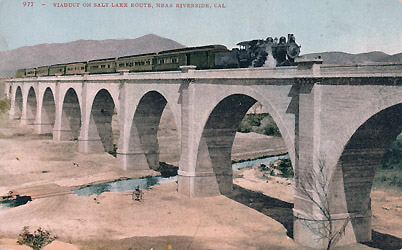 The U.S. economy had become truly national, almost any town could receive food and goods from any section of the country within a week or two. Factories could ship their products anywhere. Marketing became a nationwide enterprise. National politics changed as well, as some local differences blurred in the face of broader concerns.
The U.S. economy had become truly national, almost any town could receive food and goods from any section of the country within a week or two. Factories could ship their products anywhere. Marketing became a nationwide enterprise. National politics changed as well, as some local differences blurred in the face of broader concerns.
Twentieth Century Emerges
In 1900 William Andrews Clark acquired the struggling Los Angeles Terminal Railway. The railroad was reincorporated in 1901 as the San Pedro, Los Angeles & Salt Lake Railroad. In 1901 William Andrews Clark announced plans for railroad to construct a line between Salt Lake City, Las Vegas, Riverside, Los Angeles and San Pedro. In an agreement with the Union Pacific, Clark's railroad acquired the existing UP trackage in Utah and Nevada south of Salt Lake City; in turn, the UP received a 50% ownership interest in Clark's railroad in 1903. Construction of the remaining line proceeded rapidly, and the complete Salt Lake-Los Angeles line was opened on May 1, 1905. In California, Clark negotiated a trackage rights agreement allowing his new line to use the existing Atchison, Topeka and Santa Fe Railway route over Cajon Pass, in lieu of constructing its own tracks across the pass.
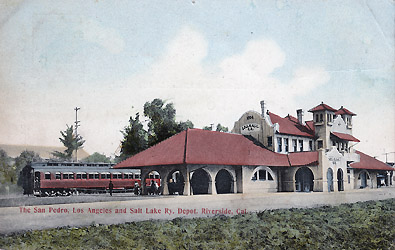 The San Pedro, Los Angeles & Salt Lake Railroad Los Angeles depot was located at First Street, on the east Bank of the Los Angeles River. The railroad was renamed the Los Angeles & Salt Lake Railroad in 1916. The line operated independently until April 27, 1921, when the UP agreed to acquire Clark's half-interest in the railroad and it became a part of the UP system.
The San Pedro, Los Angeles & Salt Lake Railroad Los Angeles depot was located at First Street, on the east Bank of the Los Angeles River. The railroad was renamed the Los Angeles & Salt Lake Railroad in 1916. The line operated independently until April 27, 1921, when the UP agreed to acquire Clark's half-interest in the railroad and it became a part of the UP system.
The Portland & Seattle Railway was incorporated in 1905, In 1908 its name was changed to Spokane, Portland & Seattle Railway (SP&S). The railroad was completed during 1908 from Pasco, Washington to Portland, Oregon, along the north bank of the Columbia River, and in 1909 the line was opened from Spokane to Pasco. Jointly financing the construction of the Spokane, Portland & Seattle Railway were the Great Northern Railroad and Northern Pacific Railway.
In 1909, the Chicago, Milwaukee & St. Paul (or Milwaukee Road) completed a privately built Pacific extension to Seattle, which on completion was renamed the Chicago, Milwaukee, St. Paul and Pacific.
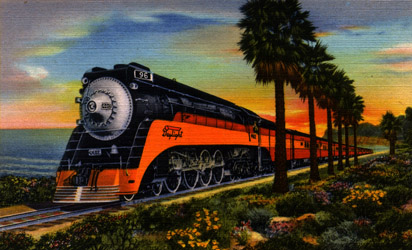 John D. Spreckels completed a privately funded San Diego and Arizona Railway in 1919 from San Diego to Calexico, California, creating a direct link (via connection with the Southern Pacific lines) between San Diego, California and the Eastern United States.
John D. Spreckels completed a privately funded San Diego and Arizona Railway in 1919 from San Diego to Calexico, California, creating a direct link (via connection with the Southern Pacific lines) between San Diego, California and the Eastern United States.
When Los Angeles Union Station opened in 1939, the Santa Fe, Southern Pacific and Union Pacific all relocated passenger service to the new station. A Harvey House Restaurant was also located in Union Station. Amtrak took over passenger operation in 1971 and continues to provide passenger service today at Union Station. The Santa Fe merged with the Burlington Northern in 1996 and continues to transport goods to and from Los Angeles as the Union Pacific, following a merger with the Southern Pacific in 1996, for more information see railroads today.
|
Orange Empire Railway Museum
Several passenger cars are used on the main line on special event weekends offering a living history experience, a demonstration freight train carries passengers other weekends offering a different type of train ride. The museum's main line follows the original Santa Fe transcontinental right of way from the museum grounds to downtown Perris. Buildings are located along the museum's mainline situated much as they were while in railroad use. Smaller objects from mainline railroads including china, keys, locks, and rule books are displayed in the Middleton collection. Several passenger cars are used on the main line on special event weekends offering a living history experience, a demonstration freight train carries passengers other weekends offering a different type of train ride. Buildings are located along the museum's mainline situated much as they were while in railroad use. The buildings are labeled describing their construction, original location and use. |
Sharing A Heritage Railroad History Train Technology Railroad Operation Railroad Time Museums & Heritage Railroads Railroads Today

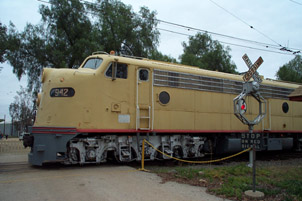 OERM's
mainline collection includes standard gauge wood, composite and steel freight and passenger cars,
diesel locomotives, maintenance of way cars, several buildings, documents and photographs. Mainline
railways represented include the Santa Fe, Union Pacific, and Southern Pacific. The oldest cars
are exhibited in the Hugh Smith Car House No. 4, passenger cars dating from 1879, freight cars
dating from the mid 1880's. Newer cars and locomotives are exhibited outside the Hugh Smith Car
House No. 4 or displayed in the Pie Yard.
OERM's
mainline collection includes standard gauge wood, composite and steel freight and passenger cars,
diesel locomotives, maintenance of way cars, several buildings, documents and photographs. Mainline
railways represented include the Santa Fe, Union Pacific, and Southern Pacific. The oldest cars
are exhibited in the Hugh Smith Car House No. 4, passenger cars dating from 1879, freight cars
dating from the mid 1880's. Newer cars and locomotives are exhibited outside the Hugh Smith Car
House No. 4 or displayed in the Pie Yard.